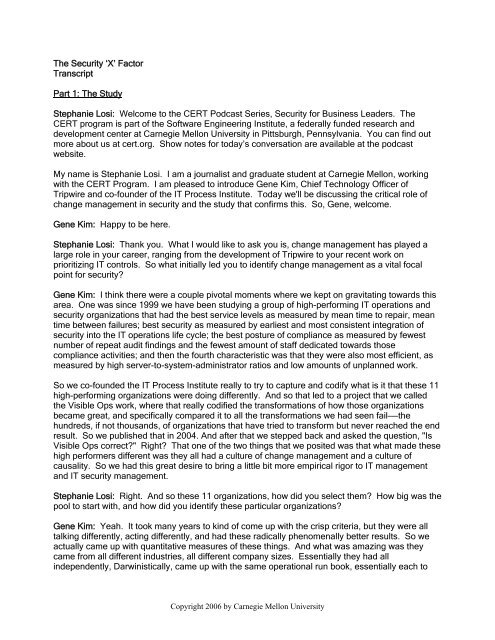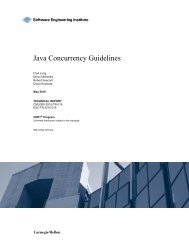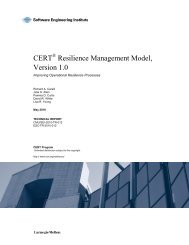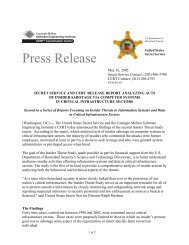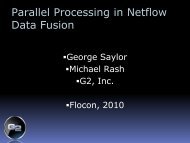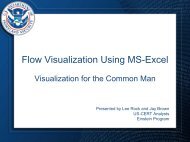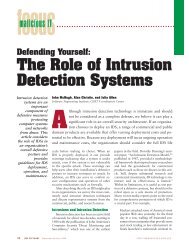The Security 'X' Factor Transcript Part 1: The Study Stephanie ... - Cert
The Security 'X' Factor Transcript Part 1: The Study Stephanie ... - Cert
The Security 'X' Factor Transcript Part 1: The Study Stephanie ... - Cert
Create successful ePaper yourself
Turn your PDF publications into a flip-book with our unique Google optimized e-Paper software.
<strong>The</strong> <strong>Security</strong> ‘X’ <strong>Factor</strong><br />
<strong>Transcript</strong><br />
<strong>Part</strong> 1: <strong>The</strong> <strong>Study</strong><br />
<strong>Stephanie</strong> Losi: Welcome to the CERT Podcast Series, <strong>Security</strong> for Business Leaders. <strong>The</strong><br />
CERT program is part of the Software Engineering Institute, a federally funded research and<br />
development center at Carnegie Mellon University in Pittsburgh, Pennsylvania. You can find out<br />
more about us at cert.org. Show notes for today’s conversation are available at the podcast<br />
website.<br />
My name is <strong>Stephanie</strong> Losi. I am a journalist and graduate student at Carnegie Mellon, working<br />
with the CERT Program. I am pleased to introduce Gene Kim, Chief Technology Officer of<br />
Tripwire and co-founder of the IT Process Institute. Today we'll be discussing the critical role of<br />
change management in security and the study that confirms this. So, Gene, welcome.<br />
Gene Kim: Happy to be here.<br />
<strong>Stephanie</strong> Losi: Thank you. What I would like to ask you is, change management has played a<br />
large role in your career, ranging from the development of Tripwire to your recent work on<br />
prioritizing IT controls. So what initially led you to identify change management as a vital focal<br />
point for security?<br />
Gene Kim: I think there were a couple pivotal moments where we kept on gravitating towards this<br />
area. One was since 1999 we have been studying a group of high-performing IT operations and<br />
security organizations that had the best service levels as measured by mean time to repair, mean<br />
time between failures; best security as measured by earliest and most consistent integration of<br />
security into the IT operations life cycle; the best posture of compliance as measured by fewest<br />
number of repeat audit findings and the fewest amount of staff dedicated towards those<br />
compliance activities; and then the fourth characteristic was that they were also most efficient, as<br />
measured by high server-to-system-administrator ratios and low amounts of unplanned work.<br />
So we co-founded the IT Process Institute really to try to capture and codify what is it that these 11<br />
high-performing organizations were doing differently. And so that led to a project that we called<br />
the Visible Ops work, where that really codified the transformations of how those organizations<br />
became great, and specifically compared it to all the transformations we had seen fail——the<br />
hundreds, if not thousands, of organizations that have tried to transform but never reached the end<br />
result. So we published that in 2004. And after that we stepped back and asked the question, "Is<br />
Visible Ops correct?" Right? That one of the two things that we posited was that what made these<br />
high performers different was they all had a culture of change management and a culture of<br />
causality. So we had this great desire to bring a little bit more empirical rigor to IT management<br />
and IT security management.<br />
<strong>Stephanie</strong> Losi: Right. And so these 11 organizations, how did you select them? How big was the<br />
pool to start with, and how did you identify these particular organizations?<br />
Gene Kim: Yeah. It took many years to kind of come up with the crisp criteria, but they were all<br />
talking differently, acting differently, and had these radically phenomenally better results. So we<br />
actually came up with quantitative measures of these things. And what was amazing was they<br />
came from all different industries, all different company sizes. Essentially they had all<br />
independently, Darwinistically, came up with the same operational run book, essentially each to<br />
Copyright 2006 by Carnegie Mellon University
prevent the last disaster from happening again. So one of my favorite quotes is, "Behind every<br />
FAA regulation is an airline crash."<br />
<strong>Stephanie</strong> Losi: So what kinds of incidents were you seeing that spurred them to really make<br />
these changes?<br />
Gene Kim: Yeah. That is a great question. <strong>The</strong>y were all high-profile outages, catastrophic<br />
incidents of unplanned work, late projects, as well as security incidents. And so our goal was to<br />
really say, "All right, is it true that a culture of change management and a culture of causality is<br />
what really discriminates high performers from low performers?"<br />
So in 2004, we started a project called the IT Performance Control <strong>Study</strong>, which is really designed<br />
to say, "Hey, there are many good things that you can do, ITIL process frameworks, COBIT control<br />
frameworks. But what they all sort of don't cover is, where do you start? <strong>The</strong>se are all sort of like<br />
dictionaries. Organizations don't do dictionaries. <strong>The</strong>y do projects, right? So our goal was to say,<br />
"All right, let’s see if we can test all of them, just like a pharmaceutical would do with a drug trial."<br />
So we took the six leading areas in ITIL that people said "here is where you should start": access<br />
management, change management, configuration management, release management, service<br />
level management, and resolution processes. And so we decided to test all of them. We picked<br />
25 control measures spanning from ops measures to security measures. And we benchmarked 98<br />
organizations over the last three years, and the goal was really to come up with better answers to,<br />
"What are the rewards of high performers in terms of performance measurements? What controls<br />
do high performers do that medium and low performers don't?" And I think there were two huge<br />
surprises that came out of this that was incredibly illuminating. <strong>The</strong> first surprise was how good the<br />
high performers were. We expected a performance difference of 2X. What we found instead was<br />
that high performers consistently outperformed their peers by a factor of 5 to 8X.<br />
<strong>Stephanie</strong> Losi: That's a lot. Okay.<br />
Gene Kim: Oh, that is amazing.<br />
<strong>Stephanie</strong> Losi: So what was causing that to happen?<br />
Gene Kim: What was different in the performance was that they were doing 8 times as many<br />
projects. <strong>The</strong>y were managing 6 times as many applications. <strong>The</strong>y were implementing 7 to 14<br />
times as many changes. When they were making the changes they had one-half the change<br />
failure rate, one-quarter of the first fix failure rate, five times higher server/sys admin ratios, and,<br />
incidentally, higher budgets——three times higher budgets.<br />
<strong>The</strong>re are two explanations, right? One is high performers are high performers because they have<br />
more money, but I think the more persuasive argument is IT has two jobs: deliver new projects to<br />
the business; operate and maintain what you have. And what we find is that low performers can't<br />
do either, and so therefore they can't get budgets to do anything. Incidentally, the security<br />
difference between high performers and medium and low performers is almost the same: 5 to 8X.<br />
What percentage of security incidents result in a loss event? High performers it was like one-fifth.<br />
What percentage of security incidents result in a loss? About one-fifth. And again, three times<br />
higher budgets between high performers and low performers.<br />
<strong>The</strong> second big surprise is, what are the high performers doing differently? We found out of the six<br />
ITIL processaries, the 63 controls that fit them, there were two controls that every high performer<br />
had that none of the medium and low performers had. So, in other words, they were universally<br />
Copyright 2006 by Carnegie Mellon University
present in high, universally absent in medium and low. And those two things were: Do you monitor<br />
systems for unauthorized change, but just as important is, do you have defined consequences for<br />
intentional and unauthorized change?<br />
<strong>Stephanie</strong> Losi: Interesting. Okay. And so the first one fits right back to Tripwire, so obviously<br />
that was of great interest to you. So when you looked at these conclusions, what did you think<br />
about them, and did you communicate these findings to the organizations?<br />
Gene Kim: Oh, absolutely. <strong>The</strong>y say the goal of science is to explain the most amount of<br />
observable phenomena with the fewest number of principles, confirm deeply held beliefs, and<br />
reveal surprising insights. And I think that the two discriminate controls——monitoring systems for<br />
unauthorized change and defining consequences——really, when you hold that up against the light<br />
with Visible Ops, I see a culture of change management that says tone from the top. Whoever is at<br />
the top of the organization says, "Change management is so important to us that the only<br />
acceptable number of unauthorized changes is zero. And we're not going to manage by belief.<br />
We have to manage by fact, and we're going to hold people accountable to that, and we're going to<br />
put controls in place so that we can find variance before causes or production outage, or security<br />
incidents." I think it definitely validated some beliefs that we have strongly held. But I think more<br />
importantly it simplified what is important, and I think helps the management focus on what is<br />
keeping them from being high performers.<br />
<strong>Part</strong> 2: Taking Action<br />
<strong>Stephanie</strong> Losi: What would you say to a company that really doesn't have a change management<br />
process in place right now? How do they get there? And then how do you enforce that down in<br />
the trenches as well, because it's one thing to say, "Well, there will be no unauthorized changes,"<br />
and another to really enforce that when someone is under pressure and they have a deadline<br />
coming up, and they need to get it done.<br />
Gene Kim: Exactly. Oh, in fact, how many times have I heard that? Absolutely. "Our business is<br />
so dynamic that we cannot——suddenly we have to break the rules." Right?<br />
So the way that we need to coach the CIO to sort of keep the organization on the wagon is<br />
essentially by having them publish three things. One is a list of all scheduled authorized changes.<br />
<strong>The</strong> second was a list of all unauthorized changes. <strong>The</strong> third one is, what are the consequences<br />
and the ramifications to that person who made those unauthorized changes? And so working with<br />
the audit community, if you can imagine, this is going to be the plan that they would put IT<br />
management on, and the goal here is to say, "All right, the declaration is good. Now prove to me<br />
on an ongoing basis that you are actually following these procedures." And I think what is just so<br />
neat about auditors is kind of the third step, which is: Trust is not a control. Hope is not a strategy.<br />
So what we are going to do is we are going to look for all unplanned outages. Really, the theory<br />
there is that behind every outage——unplanned outage——is a failure in the change control process.<br />
So where would we look if we want to find evidence that the change control process really isn't<br />
working? Just look for the outages, and that is very hard to hide.<br />
<strong>Stephanie</strong> Losi: And I have a question for you about why you think change management turned<br />
out to be such a strong determinant of overall security performance? We've seen that it is so<br />
important to get it in there to become a high performer, and that you have to really kind of tackle it<br />
from the top and get the tone from the top all set, and then make sure it's enforced in the trenches.<br />
So if an organization is going to go through this, is going to tackle what could be a significant<br />
project to really change the culture of the organization as regards this, I think they should<br />
understand why do you think this turned out to be such a strong determinant.<br />
Copyright 2006 by Carnegie Mellon University
Gene Kim: What a great question. In fact, this is still something we are still really trying to gain an<br />
understanding of, but I think if you look back far enough in the security theory, the people in the old<br />
electronic data processing age, they would say there are three places where security must hang<br />
their hat. One is access controls. Do only appropriate people have access to computing<br />
infrastructure? <strong>The</strong> second one was change. Are all changes being controlled in a way that<br />
makes sure that you're not drifting into some uncontrolled configuration state? And the third one is<br />
a fallback, is business continuity. Can you bring back and restore service when it goes down at<br />
inopportune times?<br />
I think what we're seeing is that when you look at high, medium, and low performers, you don't get<br />
the breakthrough in performance until you tackle change. I found two security executives who<br />
went into organizations and saw that there was no change control process, and they made the<br />
determination that their success hinges on having control over changes, and so they created the<br />
change management process, which is something I had never seen before. So I think it confirms<br />
deeply held intuitions for the practitioners decades ago, and we can even see how it is influencing<br />
security executives now. So, to answer your question, I think it's one thing to keep bad people<br />
away from business infrastructure, but in order to really make sure that you have a baseline, that<br />
you do not drift to a baseline, that security has to be a part of the change approval process, and<br />
they have to know when someone is circumventing the controls, because if you don't have control<br />
over change, then you really do not have control at all.<br />
<strong>Stephanie</strong> Losi: This is only coming out recently, and it seems to be a really strong finding in terms<br />
of the results of the study. We have known about access controls for years. I mean, there has<br />
been almost this obsessive focus on passwords and smart cards, file permissions, making sure<br />
only authorized users can access the resources they are supposed to access. Now, why do you<br />
think there is such a focus on access controls versus change management, especially as change<br />
management proved to be the determining factor in this study, and how would you propose shifting<br />
that in the larger security culture?<br />
Gene Kim: Oh, boy, another great question. I think the reason that security gravitates towards<br />
access controls is typically they are in complete control over it, kind of the issuance and revoking<br />
of entitlements and access, provisioning when business users are hired or fired. <strong>The</strong> link to<br />
change management is not often as strong in the job descriptions. And so I think we see two<br />
things happening. One is that in the high-performing organizations there is always some champion<br />
for the change management process, and when that exists, they own the prosecution of<br />
unauthorized change. So the instant an unauthorized change is made, essentially if operations<br />
doesn't prosecute that to completion, then it becomes security's responsibility.<br />
I think what we're seeing now is that when organizations don't have that champion for change<br />
management process, security executives are actually stepping up and saying, "Hey, in order to be<br />
secure, in order to have timely detection of variance before it causes a loss event, we need some<br />
sort of change management process." So they're actually willing these processes into being and,<br />
going back to the benchmarking findings, providing not only huge security benefits, but also huge<br />
operational benefits as well——more projects, more changes, better change success rates, better<br />
first-fix failure rates, higher server/sys admin ratios, I mean, I think, evidence that security is<br />
helping improve daily operations.<br />
<strong>Part</strong> 3: Overcoming Hurdles<br />
<strong>Stephanie</strong> Losi: All right. Let’s say an organization is implementing a change management<br />
process. What are some of the likely hurdles they might encounter? Do you ever find that there is<br />
Copyright 2006 by Carnegie Mellon University
esistance among employees to this idea, or do they tend to just go along with it? And if there are<br />
hurdles, how can an organization overcome them?<br />
Gene Kim: Yeah. I think the biggest hurdle is the perception that change management is<br />
bureaucratic, slows things down, and sucks the will to live out of everybody it touches. When we<br />
look at the benchmarking findings, we find that this is absolutely not the case. <strong>The</strong>y are getting<br />
more projects done. <strong>The</strong>y are getting more changes done with a higher change rate, and they are<br />
getting less unplanned work due to failed changes.<br />
So I think there are three common misperceptions that are quickly formed by the organization.<br />
One is, "We can't enforce a change management process because we need our people to be<br />
creative. <strong>The</strong>y are like precious birds. You can't put them in a cage." And I think the mis-thinking<br />
there is that building cars is very creative, but you can't have people moving equipment around on<br />
the production line. Second one is, "Our people are too highly paid for us to micromanage." I think<br />
what we find is that when you deal with something as mission critical as IT, the worst thing that can<br />
happen is for you not to have control, and you look at the difference between high and low<br />
performers. But I think the third one is maybe the most interesting to me, which is that it's always<br />
easier to draw pretty process diagrams on whiteboard or implement a technology. At a certain<br />
point management has to really earn their pay and figure out, "What do you do when Joey keeps<br />
making unauthorized changes?" At a certain point, management must make the call that, "Hey,<br />
the risk is so high around this, we have to put Joey in a role where he cannot make changes<br />
anymore." It doesn't mean firing him, it just means putting him in a role that's more suited to his<br />
temperament.<br />
<strong>Stephanie</strong> Losi: So if an organization has implemented change management but is not seeing any<br />
improvement, do you think some of these things might be at the root of that, or might it be other<br />
issues? What might be wrong, and where would you tell the organization to look based on your<br />
experience with change management rollouts?<br />
Gene Kim: Great question. So I think the benchmarking findings can help us there. I would look<br />
for the top two controls. Are they present? Do you have tone at the top as defined by defined<br />
consequences for intentional unauthorized change? <strong>The</strong> second thing I would look for is, are you<br />
enforcing a change management process to do controls, or is it just a meaningless binder on the<br />
bookshelf?<br />
<strong>The</strong> second thing is I would look for metrics where, if you are doing change management right, you<br />
should be able to see immediate improvements around. One is number of unplanned outages.<br />
Every time you have an unplanned outage, that is a failure in the change control process. So if<br />
you are doing the right things, you're not going to have these 2:00 a.m. all-hands-on-deck<br />
situations.<br />
<strong>Stephanie</strong> Losi: Everybody would like not to have those.<br />
Gene Kim: Absolutely. <strong>The</strong> second thing is look for reduction in mean time to repair. What you<br />
want to see is——80% of all issues are caused by change——so you want to see people ruling out<br />
change first in the repair cycle, not last. And then one of my favorite metrics is change success<br />
rate. What percentage of changes actually work the first time and happen on schedule? And we<br />
find that high performers have change success rates of over 90%. Low-performing organizations<br />
sometimes as low as 50, 60%.<br />
<strong>Stephanie</strong> Losi: Right. And that is because of their change management process.<br />
Copyright 2006 by Carnegie Mellon University
Gene Kim: Absolutely. Right. In fact, it is very difficult to bring your change success rate up to<br />
over 50, 60% without having some control over how you're making changes. And the enterprising,<br />
ambitious person might also even look at first-fix rate. What percentage of your fixes worked the<br />
first time, so when you have an incident or an outage or security incident, how many of your<br />
restoration procedures actually worked the first time? Best-in-class is again 90%, worst-in-class is<br />
50% or below.<br />
<strong>Stephanie</strong> Losi: All right. Thank you very much, Gene. This has been great. Do you have any<br />
resources that you would point leaders to if they are considering implementing change<br />
management in their organization? Where should they look? Where should they go just to kind of<br />
get a background on this before they get started?<br />
Gene Kim: Absolutely. You can find the Visible Ops Handbook at the ITPI website. That is<br />
itpi.org. In fact, you will see Julia Allen is the person who wrote the foreword to that. And the other<br />
work that Julia Allen and I worked on is the Change Management Audit Guide through the Institute<br />
of Internal Auditors. And you can find that on the iia.org website.<br />
<strong>Stephanie</strong> Losi: Thank you very much. It’s been a pleasure having you.<br />
Gene Kim: Thank you.<br />
Copyright 2006 by Carnegie Mellon University


